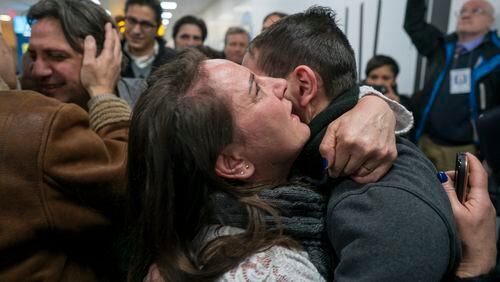Claiming President Donald Trump’s ban on travel would “unleash chaos again,” lawyers for Washington state and Minnesota asked a federal appellate court to keep in place a restraining order that halts the ban and allows immigrants into the country.
The filings with the 9th U.S. Circuit Court of Appeals in San Francisco came early Monday after the White House said it expected the federal courts to reinstate the ban.
According to The Associated Press, the filings claim that both Washington and Minnesota said their underlying lawsuit was strong and a nationwide temporary restraining order was appropriate. If the appellate court reinstated Trump's ban the states said the "ruling would reinstitute those harms, separating families, stranding our university students and faculty, and barring travel."
>>Watch the hearing from the 9th Circuit Court live here.
How did we get to this point with the executive order banning immigration? Here’s a look at the ban, the court challenge and what’s next.
First, what does the ban do?
The ban originally:
• Suspended the U.S. refugee admissions program for 120 days
• Indefinitely suspended Syrian refugees from entering the country
• Banned entry for refugees from seven majority-Muslim countries – Iran, Iraq, Libya, Somalia, Sudan, Syria and Yemen – for 90 days
• Banned entry for 90 days of dual-nationals who are from those seven countries, but have an additional passport
• Prioritized refugee claims on the basis of religious persecution, as long as the applicant is a member of a religion that is a minority in their country of origin
• Lowered the total number of refugees to be accepted from any country in 2017 to 50,000
What happened Friday?
U.S. District Court Judge James Robart of Seattle issued a ruling Friday on a request for a restraining order brought by the state of Washington that would suspend sections of the travel ban signed by Trump on Jan. 27.
The state of Washington contended that certain parts of the travel ban are contrary to the Constitution and the laws of the United States. The state asked for a nationwide ban on the order.
Robert’s decision did three things – first, it recognized that Washington and a second state that joined in on the request, Minnesota, had standing to ask for a restraining order. In other words, they were being harmed by the ban, so they could ask a court for help.
Second, the ruling required that the section of the travel ban that called for a 90-day halt to immigration from the seven countries, and the section that called for an indefinite suspension of immigration from Syria be lifted.
Third, the order put a halt to prioritizing refugee claims of certain religious minorities.
The administration appealed to the 9th Circuit Court of Appeals to have the restraining order lifted, allowing the travel ban to continue. The court ruled against the administration on Sunday.
So it’s a done deal, the travel ban is lifted?
No, far from it. What happened on Friday was that a judge issued a temporary restraining order. That means the travel ban stops temporarily until a full hearing is held.
What happened on Sunday was that the Trump administration asked to have the restraining order lifted. The court did not lift the order, leading to the full court hearing which is taking place Tuesday in San Francisco in the 9th Circuit Court of Appeals.
What did the Trump administration do after the order was issued in Washington?
The administration did what the court ordered, and suspended the ban.
"In accordance with the judge's ruling, DHS has suspended any and all actions implementing the affected sections of the Executive Order entitled, "Protecting the Nation from Foreign Terrorist Entry into the United States," DHS said in a statement.
When could the ruling come?
The 9th Circuit Court of Appeals has asked for both sides to file legal briefs before the court makes its final decision. Washington and Minnesota filed theirs Monday morning. The government has until 6 p.m. ET Monday evening to submit its briefs.
What happens if the court upholds the restraining order?
That means the travel ban is on hold – unless or until the administration appeals the decision, which seems likely.
If the judges rule in favor of the administration, the restraining order on the travel ban is lifted and it goes back in force.
About the Author






